Last updated: April 14, 2023
Article
Ladd Field and the Lend-Lease Mission: Defending Alaska in WWII (Teaching with Historic Places)
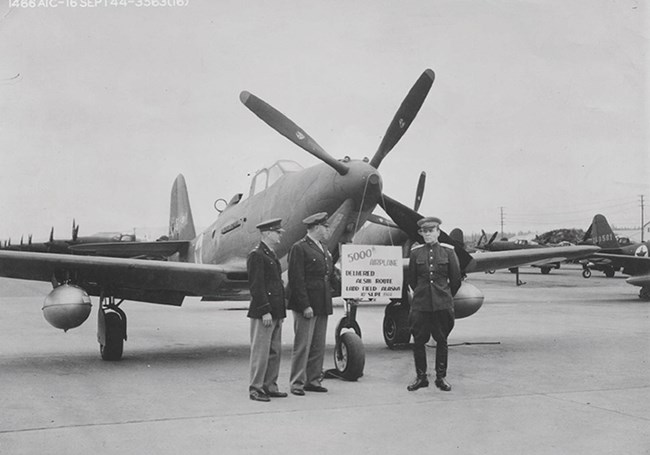
Imagine yourself a military man in Alaska, living in a plywood hut that offers little comfort in the winter months. You watch one of your bunkmates trying to clean the quarters, but before he can mop up the water he's used to scrub the floor, it freezes. Fortunately, you can sleep tonight, as it's not your turn to stay up to keep the fire going. But the coal used for the fire is dirty and poor ventilation traps the fumes inside, making everyone feel sick. This would have been your life had you been assigned to work at Ladd Field when it first opened near the town of Fairbanks, Alaska, as a Cold Weather Testing Station on the eve of World War II.
Ladd Field broke ground in 1939, just a few days before World War II began in Europe. Once the United States entered the war, the facility became a transfer point for American aircraft bound for the Soviet Union. The airfield's evolving mission from a Cold Weather Test Station to a key player in the Lend-Lease program reflects the significant role the most remote part of our country played in the war. Ladd Field served as the meeting point for the Soviets and the Americans to exchange planes manufactured under the Lend-Lease Act. The Lend-Lease Act was designed to provide allies with aircraft and supplies for the war in Europe. As such, Ladd Field came to represent not only a political and economic exchange, but a cultural one as well.
Despite the economic and human resource issues Ladd Field faced, its "raw wind and incredible temperatures" could not stop the soldiers or the people who lived and worked there from protecting Alaska, the United States, and the world.
1 Price, Kathy. The World War II Heritage of Ladd Field, Fairbanks, Alaska. Center for Environmental Management of Military Lands, 2004.
About This Lesson
This lesson is based on the National Register of Historic Places nomination file, "Ladd Field" (with photographs), and other source materials regarding Ladd Field and the Alaska-Siberia (ALSIB) staging route during WWII. The lesson was written by Sarah Evridge, a teacher and edited by Darrell Lewis, a historian from the National Park Service in Anchorage, Alaska, and the staff of the Teaching with Historic Places (TwHP) program. This lesson is one in a series that brings the important stories of historic places into classrooms across the country.
Where it fits into the curriculum
Topics: This lesson could be used in units on World War II, especially the American Lend-Lease program; military history; early military aviation; and Alaska history. It will assist students in understanding the role of Ladd Field during WWII and the unique role it played as part of the Alaska-Siberia (ALSIB) staging route between Alaska and the Soviet Union.
Time period: mid-20th century
Relevant United States History
(Standards for Grades 5-12)
Ladd Field and the Lend-Lease Mission: Defending Alaska in WWII
relates to the following National Standards for History:
Era 8: The Great Depression and World War II (1929-1945)
-
Standard 3: The causes and course of World War II, the character of the war at home and abroad, and its reshaping of the U.S. role in world affairs.
-
Standard 3A: The student understands the international background of World War II.
-
Standard 3B: The student understands World War II and how the Allies prevailed.
-
Standard 3C: The student understands the effects of World War II at home.
Curriculum Standards for Social Studies
(National Council for the Social Studies)
Ladd Field and the Lend-Lease Mission: Defending Alaska in WWII
relates to the following Social Studies Standards:
Theme I: Culture
-
Standard C-The student explains and gives examples of how language, literature, the arts, architecture, other artifacts, traditions, beliefs, values, and behaviors contribute to the development and transmission of culture.
Theme II: Time, Continuity, and Change
-
Standard F-The student uses knowledge of facts and concepts drawn from history, along with methods of historical inquiry, to inform decision-making about and action-taking on public issues.
Theme III: People, Places, and Environments
-
Standard A-The student elaborates mental maps of locales, regions, and the world that demonstrate understanding of relative location, direction, size, and shape.
-
Standard D-The student estimates distance, calculates scale, and distinguishes other geographic relationships such as population density and spatial distribution patterns.
Theme VI: Power, Authority, and Governance
-
Standard F-The student explains conditions, actions, and motivations that contribute to conflict and cooperation within and among nations.
-
Standard G-The student describes and analyzes the role of technology in communications, transportation, information-processing, weapons and development, and other areas as it contributes to or helps resolve conflicts.
-
Standard I- The students give examples and explain how governments attempt to achieve their stated ideals at home and abroad.
Theme IX: Global Connections
-
Standard A-The student analyzes examples of conflict, cooperation, and interdependence among groups, societies, and nations.
Objectives for students
1) To identify the changing missions of Ladd Field over time and explain its role during WWII.
2) To describe the cooperation between the Soviets and Americans during the war and to determine whether the Lend-Lease program was a success or a failure.
3) To analyze the importance of the Lend-Lease program in helping the Allies win WWII.
4) To discuss the impact of WWII in their own community based on research and interviews.
Materials for students
The materials listed below can either be used directly on the computer or can be printed out, photocopied, and distributed to students. The maps and images appear twice: in a low-resolution version with associated questions and alone in a larger, high-resolution version.
1) Three maps: The first is of major military sites in Alaska during WWII; the second shows Ladd Field in relation to Fairbanks; the third map illustrates the ALSIB route in starting in North America and ending in the Soviet Union.
2) Three readings: The first reading discusses the origin and history of Ladd Field; the second discusses the creation of the ALSIB route; and the third covers the cooperation between the American and Soviet allies.
3) Six photos of Ladd Field from its beginning to the height of the Lend-Lease mission in WWII.
Visiting the site
Ladd Field is located on Fort Wainwright, near Fairbanks, Alaska. Fort Wainwright is an active Army installation and all visitors must stop at the Visitors Center located outside the Main Gate. Visitors can drive along a self-guided tour of the historic district, which is explained through interpretive panels and a booklet. The site's brochure can be downloaded here.
The best time to visit Alaska and Ladd Field is May through September. For more information, visit Fort Wainwright's website or contact Lisa Graham, Cultural Resource Manager at: 907-361-3002.
Getting Started
Inquiry Question
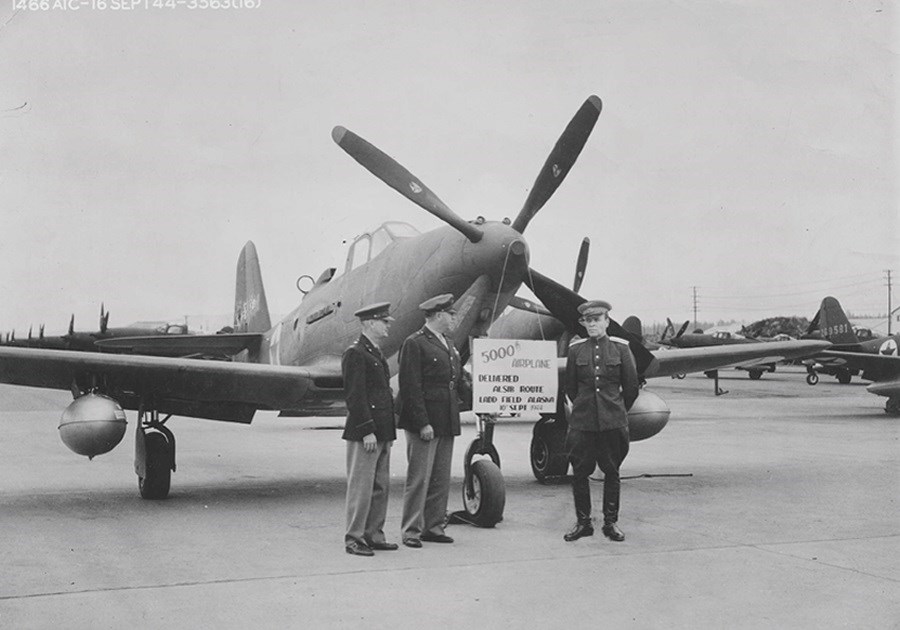
What do you think is going on in this picture? When do you think the picture might have been taken?
Setting the Stage
After WWI ended in 1918, President Woodrow Wilson presented his plan for a League of Nations to prevent further conflict. The League of Nations was an international organization, based in Geneva, Switzerland, where representatives of member nations met to resolve international issues. It preceded the United Nations. Although the idea was presented by the President of the United States, the U.S. Congress refused to ratify the treaty permitting America to join the League. Throughout the next two decades, a feeling of isolationism reigned. This desire for separation was buoyed in the 1920s by a relative rise in prosperity throughout the country. In the 1930s, tension grew in Europe and Asia as Germany and Japan became increasingly militaristic, even invading neighboring countries. Politicians in Washington were keeping a close eye on events around the world but the United States was hoping to stay out of any conflict. Many Americans did not want to get involved in another war.
Locating the Site
Map 1: Alaska WWII Major Military Sites.
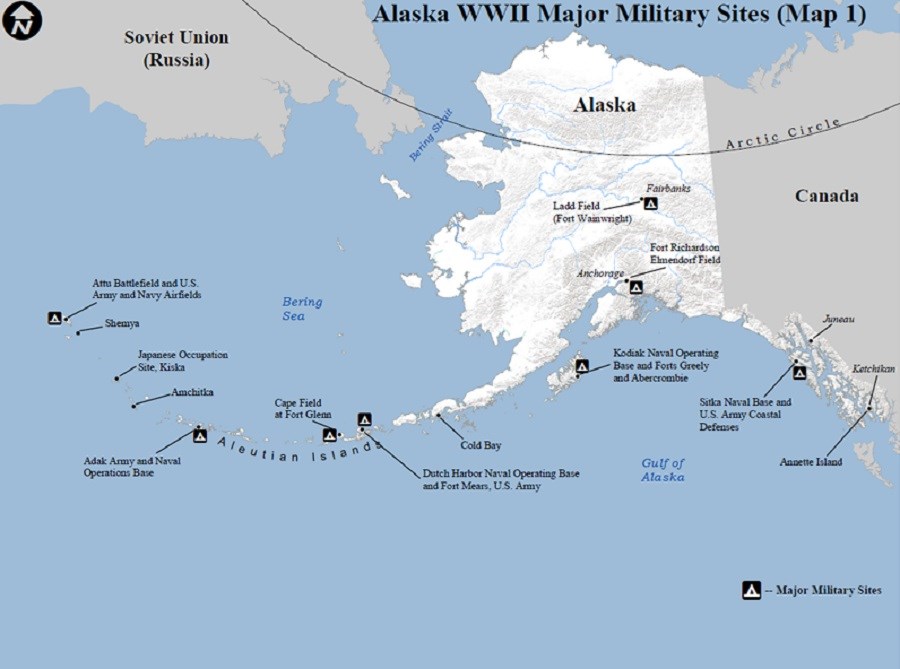
(Fort Wainwright Cultural Resources Department)
Questions for Map 1
1. Where are the Aleutian Islands?
2. Where is Ladd Field located within Alaska? Is it in the Arctic?
3. What countries border Alaska?
4. How many military bases can you identify on the map? Why do you think Alaska was a strategic military location during WWII?
Locating the Site
Map 2: Ladd Field's Proximity to Fairbanks.
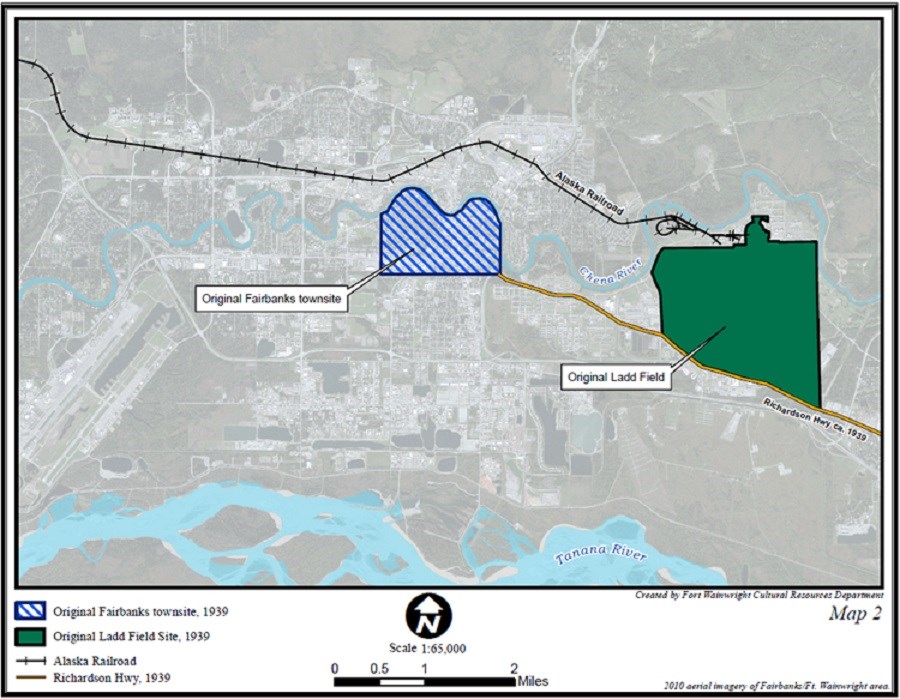
(Fort Wainwright Cultural Resources Department)
Questions for Map 2
1. How close is Ladd Field to the town of Fairbanks?
2. How were civilians and military personnel able to go back and forth between Ladd Field and town?
3. How do you think the town of Fairbanks might have supported Ladd Field?
Determining the Facts
Reading 1: Ladd Field and Cold Weather Testing
Even after World War I ended in 1918, tensions in Europe continued. Many politicians in the United States believed that our nation needed to prepare itself for possible future conflict. Alaska was not yet a state, but did send a delegate to Congress. U.S. territories can elect delegates to represent them in Congress, but those delegates cannot vote. Alaska's delegate, Anthony Dimond, worked hard to persuade Congress that Alaska needed a defense system. Major General H.H. Arnold, Chief of the Army Air Corps, insisted on the establishment of an airbase. The 1935 legislation authorizing Ladd Field, named for a pilot who had lost his life, allowed for military facilities in Alaska, but did not fund them. The United States did not begin building Ladd Field until 1939. Just days later, Germany invaded Poland. World War II had begun.
Ladd Field opened near Fairbanks, Alaska, in 1940. It originally served as a Cold Weather Test station. The local weather was well suited for it. Winter in Fairbanks can start as early as September and lasts until late April or early May. Low temperatures generally average -15˚ to -25˚ Fahrenheit. However, the temperature each winter drops to more than -60˚ Fahrenheit. Snow begins to accumulate in early October and usually does not disappear until the following May. The Cold Weather Test Station was tasked with making sure aircraft would start and fly at these extreme temperatures.
More troops arrived in September, 1940. Construction of buildings and the runway continued into 1941. Portable hangars housed the airplanes until the first permanent hangar was finished. By the fall of 1941, over 500 troops were stationed at Ladd Field. However, many were only temporary. Base Commander Lt. Colonel Dale W. Gaffney complained to his superiors that it was difficult to mount a testing program with limited personnel and incomplete facilities. Also, rumors circulated that Ladd Field would be used for other purposes.
Despite slow construction and limited supplies, testing continued at Ladd Field until the spring of 1942. The Cold Weather Test Detachment learned a lot. They learned about wing icing (how to deal with ice that forms on the plane's wings), navigation, cold-weather clothing, armament, and other aspects of operating aircraft in arctic-like conditions. The military used this data as it built new aircraft. Incorporating lessons learned in Alaska helped make operating American aircraft in arctic weather conditions safer.
The Japanese attack on Pearl Harbor in 1941 pushed the United States into WWII. In 1942, the Japanese invaded the Aleutians Islands in western Alaska. As a result, the United States Army disbanded the Cold Weather Testing Detachment. The soldiers went to other military posts in Alaska to help fight the Japanese in the Aleutian Campaign. Ladd Field became a storage area to repair and service aircraft. Several months later, the Commanding General decided that more cold weather testing was necessary. He reactivated the Cold Weather Test Detachment. Aviation testing continued well after the conclusion of WWII in 1945.
In 1947, Ladd Field became a United States Air Force Base. In 1961, the facility was transferred to the Army and became Ft. Wainwright. Ladd Field/Ft.Wainwright is still an active Army installation. The buildings and structures in the historic district emphasize Ladd Field's national significance during WWII—as a cold weather test facility, as a support base for the Aleutian Campaign of the War in the Pacific, and for its role as the transfer site for aircraft along the Alaska-Siberia Route.
Questions for Reading 1
1. What was the original mission of Ladd Field? Why was its location so well suited for this type of work?
2. What event caused the Cold Weather Test Detachment to disband?
3. Do you think it was important to have a military installation in Alaska during WWII? Why or why not? What event made Alaska, not yet a state, a desirable location for military facilities? (Look back at Map 1 if necessary.)
Reading 1 was compiled from Cold Missions: The U.S. Army Air Forces and Ladd Field in WWII; National Register of Historic Places Nomination Form, Ladd Field, Washington, D.C.: U.S. Department of the Interior, National Park Service, 1984.
Determining the Facts
Reading 2: The Lend-Lease Program and the Alaska-Siberia Route
Before World War II, the Soviet Union and Germany agreed not to fight each other if war came. This pact continued during the beginning of the war, but ended in 1941 when Hitler sent an army to attack the Soviet Union. The Germans beat the Soviet Union's unprepared Red Army in 1941 and destroyed many of its aircraft.
President Franklin Roosevelt's administration decided that the United States should help the Soviet Union. Roosevelt and his advisers believed such help was needed to help the Soviet Union defend itself. Congress had passed the Lend-Lease Act in 1941, in part in response to a request from Great Britain for aid. At first, this Act allowed the United States to provide assistance while preserving its neutrality. When Germany attacked the Soviet Union in 1941, the U.S. formally offered aid to the Soviets. This strategy to defeat Germany had support at high levels.
The Lend-Lease Act sent materials and supplies to American allies. Under the Lend-Lease Act, based on records from the 1940s, the United States provided 50 billion dollars worth of war material to 32 allies. Approximately 11 billion dollars of this went to the Soviet Union. The supplies sent to the Soviet Union included 427,000 trucks, 13,000 combat vehicles, and nearly 15,000 combat planes. It also included other items, from diesel engines to shoes.
After the decision to help the Soviet Union, the transfer of aircraft via the ALSIB became a priority. In August 1941, the United States and the Soviet Union reached an agreement on a plan to deliver Lend-Lease supplies. Two routes were selected to get supplies to the Soviet Union. One began in Florida, stopped in North Africa, then Iraq, and ended in Moscow. This route was 13,000 miles.
The second route began in Great Falls, Montana, and went through western Canada to Ladd Field, then continued to Siberia, and finally to Moscow. This route totaled 7,900 miles. Other routes by sea and air were used to supply Lend-Lease equipment, but going through Alaska was shorter and less dangerous than routes by sea. The routes by sea were longer and also dangerous due to German submarines. Since the route through Ladd Field was safer and shorter, the transferred planes made it to the European front within days instead of weeks or months. This route became known as the Alaska-Siberia Route (ALSIB). The United States constructed seven airfields in central Alaska, one at Northway, Tanancross, Big Delta, Ladd Field (Fairbanks), Galena, Moses Point, and Nome. Canada was already building six airfields between Edmonton and Whitehorse. This completed the Alaska-Siberia Route for the delivery of aircraft to the Soviets.
At first, the United States wanted to turn over the planes to Soviet aircrews in Siberia. However, Soviet Leader Josef Stalin did not want United States military forces flying into Soviet airfields, he insisted that Soviet pilots should accept the planes in Alaska. The U.S. and the Soviet Union agreed that Ladd Field in Fairbanks would be the delivery point, due to its strategic location and the fact that, of the routes available, it was the safest and quickest. Since the Soviets officially took ownership of the aircraft at Ladd Field, the planes were inspected and painted with a red star to denote that the aircraft were now the property of the Soviet Union. The Soviets would land at Nome for refueling and repairs before crossing the Bering Strait.
The first Lend-Lease planes flown between Great Falls and Fairbanks arrived on September 3, 1942. Five A-20 bombers made the first two-day flight. Every plane arrived with a white star on the fuselage (body of the plane). The Soviet pilots painted over the white star with the red star, the emblem of the Soviet Union, before leaving for the Soviet Union. The next day, Soviet officers flew in from Siberia. Finally, a group of Soviet pilots landed at Ladd Field on September 24 to begin five days of training before flying the new planes home.
Wartime censorship meant that the ALSIB route and the Soviet soldiers stationed at Ladd Field were not publicly discussed until the summer of 1944. However, in towns along the way, the operation was common knowledge. The Soviet pilots stayed at Ladd Field until the end of WWII. In that time, the United States delivered almost 8,000 planes to the Soviet Union.
Questions for Reading 2
1. Why did the United States create the Lend-Lease Program and what did it do? Why was the Soviet Union included?
2. What routes were proposed to get supplies to the Soviet Union? Which one was selected and why? How did the selection of this route impact Alaska?
3. How much money and materials were sent to the United State's allies under the Lend-Lease Act?
4. Do you think that the Lend-Lease program contributed to the Allies winning WWII? Why or why not?
Reading 2 was compiled from Cold Missions: The U.S. Army Air Forces and Ladd Field in WWII and the National Register of Historic Places Nomination Form, Ladd Field, Washington, D.C.: U.S. Department of the Interior, National Park Service, 1984.
Determining the Facts
Reading 3: Soviet-American Relations
The number of Soviet soldiers at Ladd Field sometimes took people by surprise. Major General Deane, the head of the U.S. military mission in Moscow, wrote about his trip to Fairbanks: "In the first place, we found that our air base at Fairbanks was at least half under Russian control. Officers' quarters, office space, hangars and shops had been turned over to the Red Air Force. Russian and American officers ate at a central mess hall. There were no restrictions whatsoever on Russian soldiers. They were free to use all the facilities of the station and to travel at will."
About 300 Soviets served at Ladd Field at the height of operations. Many more flight crews arrived on a regular basis from Siberia to pick up planes. The red star became a familiar sight in the sky over Fairbanks when the Soviets left in groups. "There was lots of activity on the field, a tremendous roaring of motors as a large convoy was getting ready to take off," wrote Henry Varnum Poor, a soldier and artist. Cold Weather Test Detachment pilot Randy Acord said the normal procedure was for a flight of thirteen airplanes to leave as a group. The bombers and pursuit planes would take off one after another, circling the field until all were ready to go. "Together they moved into a tight formation and disappeared over the western hills," Poor wrote.
Some of the planes were too small to fit an American soldier and a Soviet soldier. As a result, the American soldiers had to give instructions on the ground and watch the Soviets fly. The language barrier between the Americans and Soviets reportedly caused some problems when they were trying to do this. The Ladd Field newspaper tried to help the language differences. The newspaper included helpful Russian phrases and the base offered classes in Russian. However, the language barrier was such that sign language was often used when interpreters were not handy.
Americans complained that the Soviets were too picky about accepting planes with minor mechanical problems. David Chavchavadze, an American translator, said there was a good reason for their attitude. The North American part of the Lend-Lease route was difficult, but the Soviet segments were worse because landing fields were farther apart and more primitive. "The Americans were irritated because they did not realize that if a plane developed mechanical trouble on its way to the front or crashed, the Russian mechanic who had signed for it was held responsible."
The Soviets also became famous in Fairbanks for buying large quantities of consumer goods that were difficult to find back in the Soviet Union. One American officer remembered a time when a Soviet soldier asked to buy shoes. "What kind?" the clerk asked. "All kinds," the Russian said. "What size?" the clerk asked. "All sizes," the Russian said. The clerk sold him all the previous year's styles the store held in stock. Fairbanks was not forced to ration goods so it was a "buyer's paradise" for the Soviets.
Questions for Reading 3
1. What were some of the difficulties faced by the Soviets and Americans as they worked together? Why was it important for Soviet and American soldiers to work together?
2. How did the soldiers communicate to each other?
3. What effect do you think American and Soviet soldiers living and working together at Ladd Field had on the overall Lend-Lease mission?
4. Would it be surprising today to see soldiers from different countries on an American military base during a war?
Reading 3 was compiled from Cold Missions: The U.S. Army Air Forces and Ladd Field in WWII and the National Register of Historic Places Registration Form, Ladd Field, Washington, D.C.: U.S. Department of the Interior, National Park Service, 1984.
Visual Evidence
Photo 1: Photograph of Ladd Field under construction in 1939.
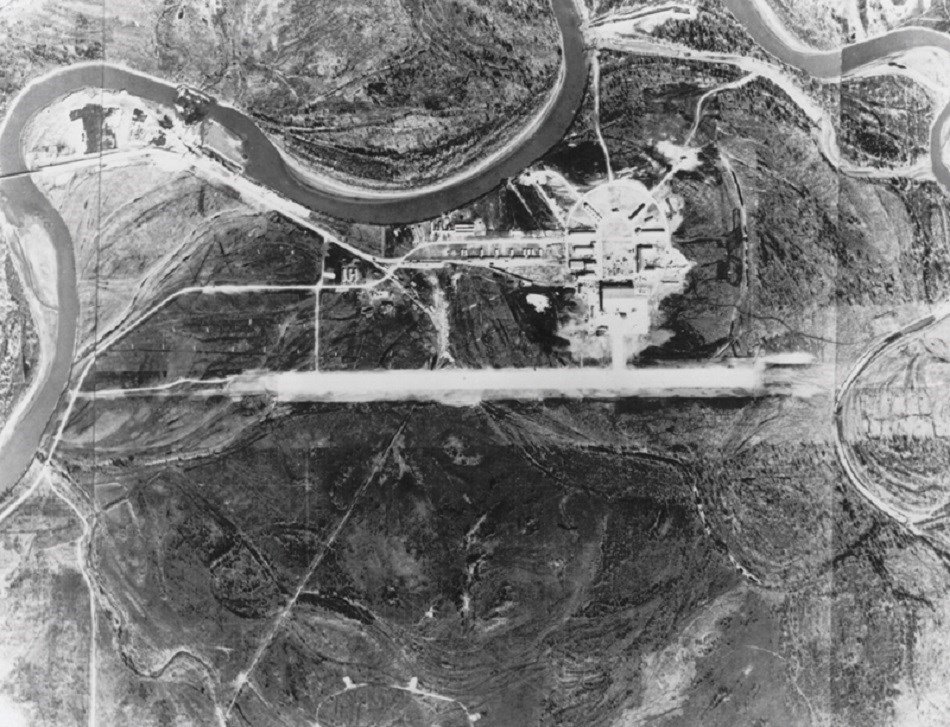
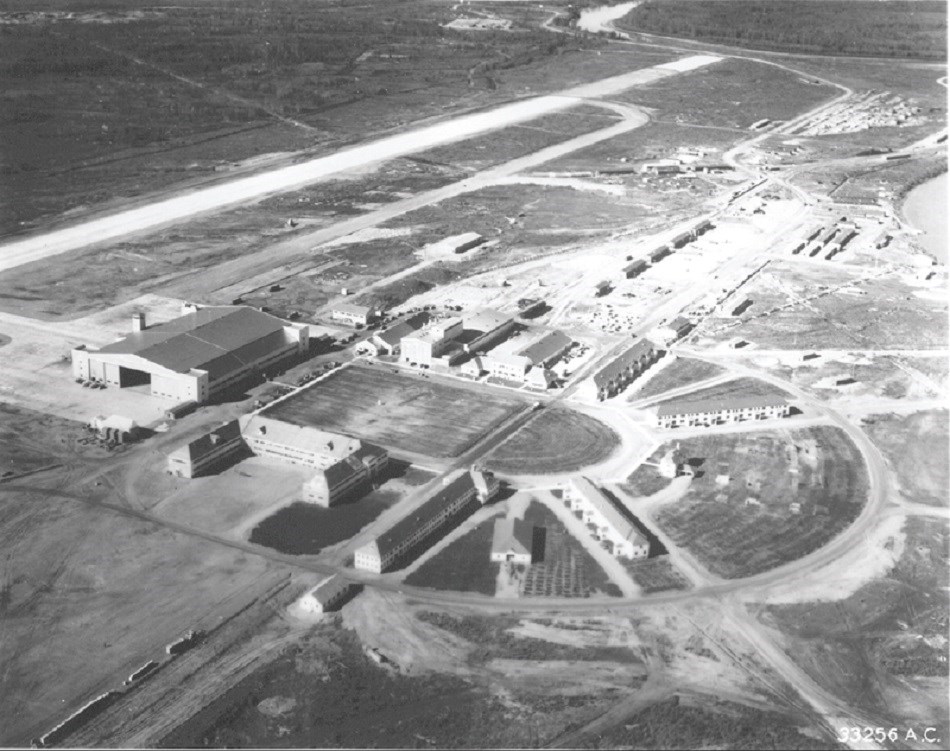
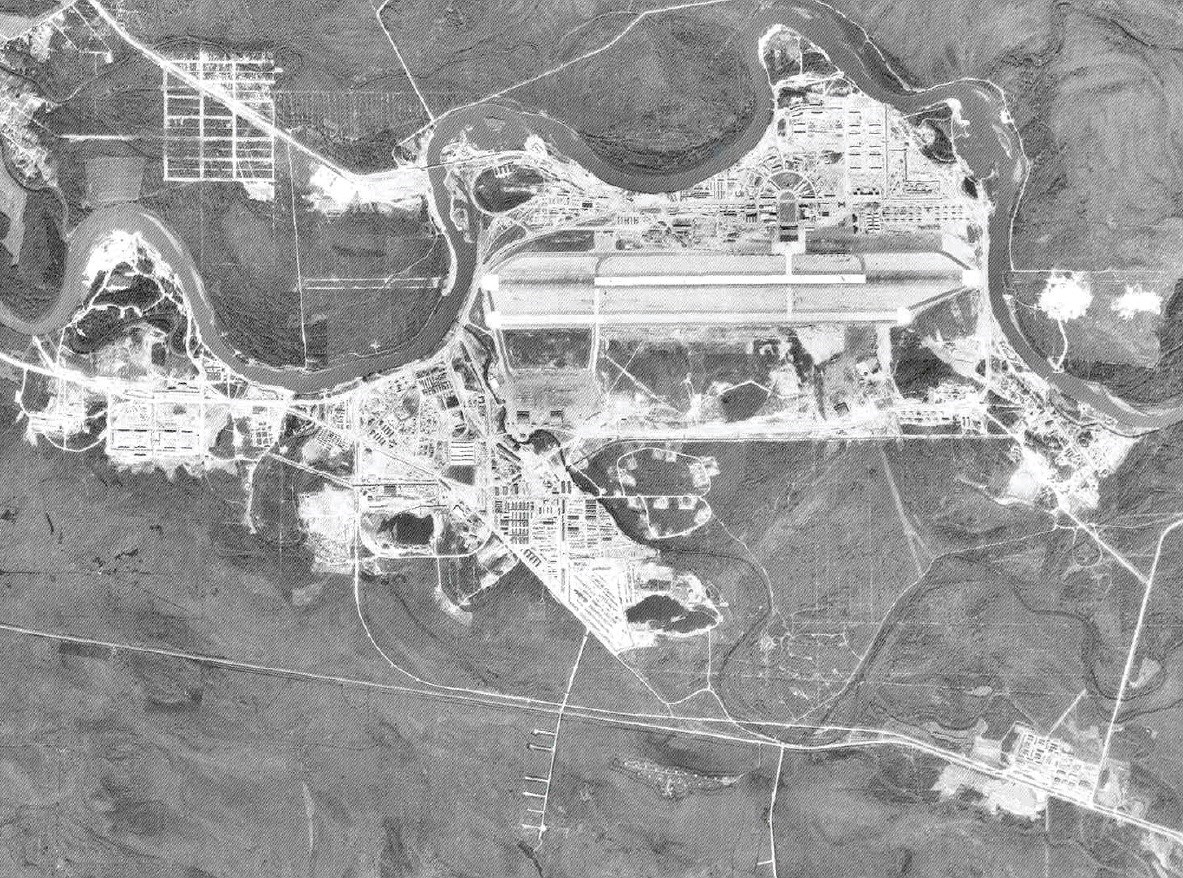
Questions for Photos 1-3
1. How many buildings can you count under construction in photo 2? Does there appear to have been a lot of new construction between 1939 and 1942?
2. What differences do you see between Photos 1 and 3? Is there a difference in size? Has anything been added? If so, what?
3. Why do you think there were so many changes between 1939 and 1946? What impact do you think the change in mission made? (Refer back to Readings 1 and 2, if necessary.)
Visual Evidence
Map 3: Map of the ALSIB Route.
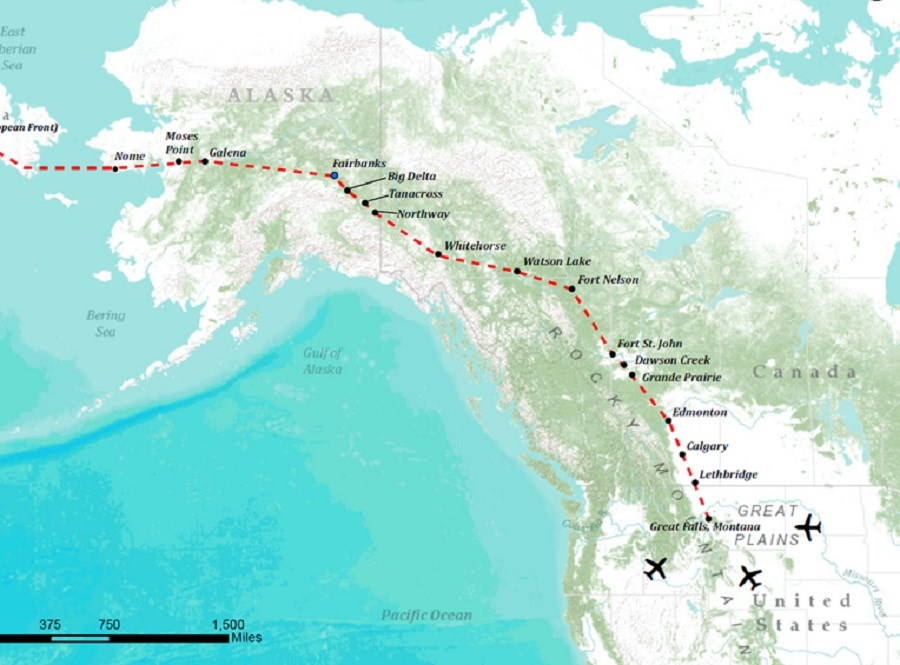
Questions for Map 3
1. Count how many landing fields there were between Great Falls, Montana and Fairbanks, Alaska. Why do you think there were so many landing fields? What factors do you think would have determined how many stops the pilot had to make before reaching Fairbanks?
2. Referring back to Reading 2, why do you think this route was chosen instead of another? (Consult an atlas if necessary)
Visual Evidence
Photo 4: White Star, Red Star.
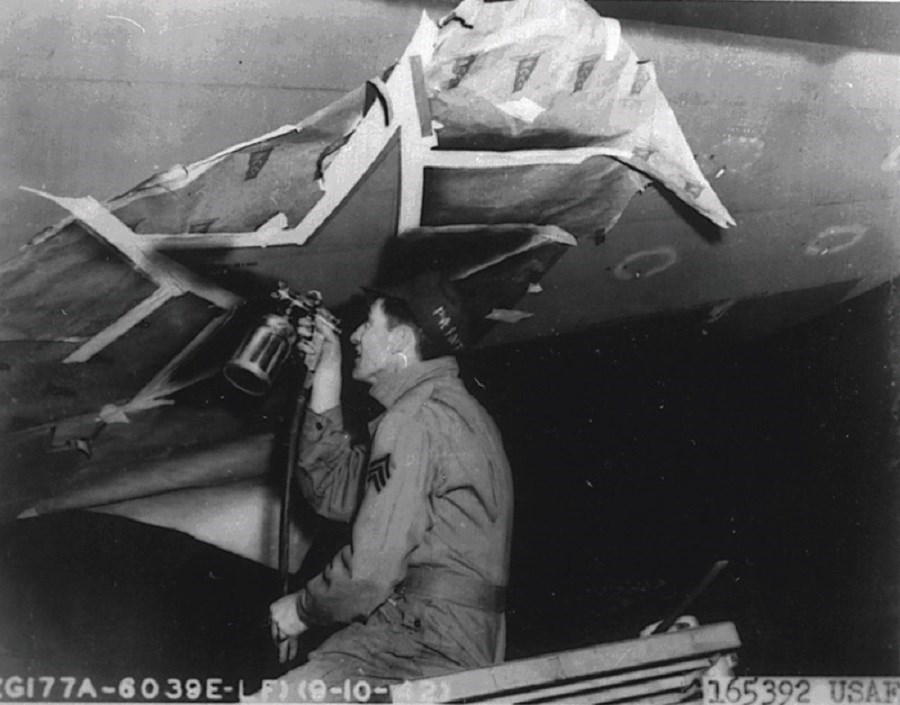
(Courtesy of the U.S. Army)
Questions for Photo 4
1. What is happening in this photograph? What does the symbol mean? (Refer back to Reading 2 if necessary)
2. Why do you think the U.S. did not deliver the planes with the red stars? (Refer back to Reading 2 if necessary)
Visual Evidence
Photo 5: International Cooperation.

(Courtesy of the U.S. Army)
Photo 6: Sign on the Plane.
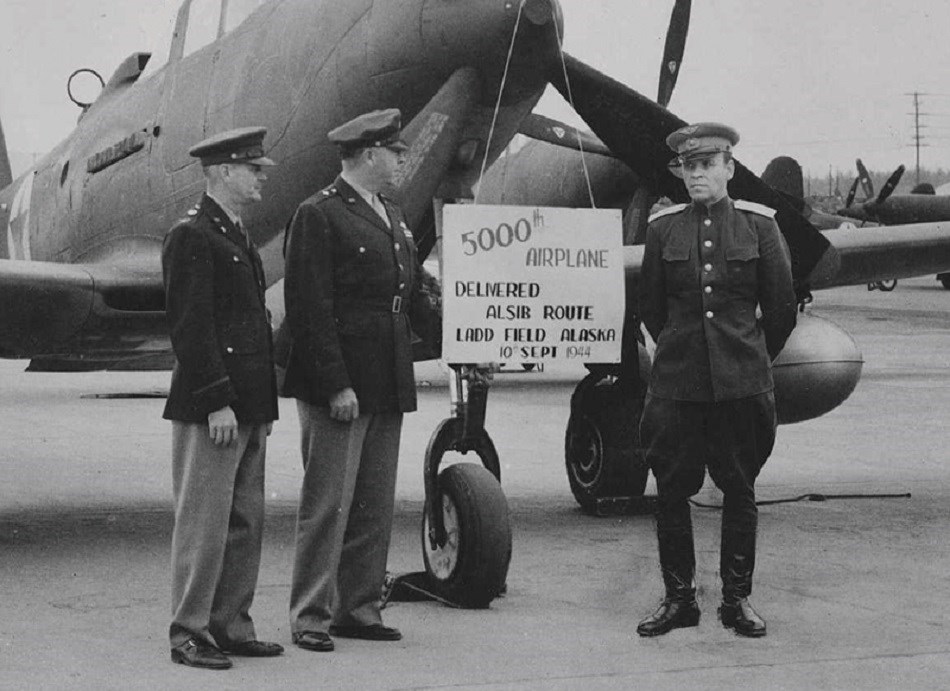
(Courtesy of the U.S. Army)
Questions for Photos 5-6
1. How many soldiers do you see in the photograph? Are they wearing the same uniform? Why or why not? What country(ies) do you think they are from?
2. Can you see anything else in the photograph that might suggest whether this plane was one of a few or a lot of planes at the airfield?
3. What does the plaque hanging on the airplane say?
4. What does this image and the sign on the plane indicate about how well the Lend-Lease Operation was going?
Putting It All Together
Ladd Field was an important military support center and example of cooperation between allies in WWII. The following activities will help students understand the importance of cooperation between wartime allies, examine the Lend-Lease Act's role in helping the Allies win WWII, and learn about the effects war has not only on whole nations, but on communities and individuals.
Activity 1: Wartime Cooperation
Divide students into four or five groups and have them research cooperation between participating countries in the American Revolution, the American Civil War, the Spanish-American War, and WWII. Assign one group to research the cooperation between Russians, Americans, and Canadians in WWII beyond the ALSIB route. (For example, students could research the building of the Alcan Highway.) As they research, students should answer the following questions:
-
Which countries cooperated together?
-
What were the motives of each?
-
How did they cooperate?
-
Did one or more countries contribute more than the other?
-
Did the process go smoothly or were there disagreements and friction between the nations (or, in extreme cases, fall apart)?
-
Was the cooperation fully, partially, or not at all successful? Why or why not? What measure(s) of success are you using?
After this research is complete, have students create a museum exhibit (as small or large as time permits), and then visit each other's exhibits where students can ask and answer questions to fill in the rest of the Wartime Cooperation Matrix.
If possible, teachers and students can arrange to invite other classes and the community (their families) to visit their Wartime Cooperation museum exhibits setup in an assembly room. Students can stand by their exhibits and explain what they studied and answer questions.
Activity 2: Lend-Lease: Success or Failure
The United States spent billions of dollars supporting its allies in WWII. This activity takes the Lend-Lease program beyond Ladd Field and the Northwest Transfer Route and has students research how the Lend-Lease Act helped the Allies win the war. Divide students into groups, in pairs, or on their own depending on class size, to research different countries and the help that they received. Then, have students create a PowerPoint or Prezi to share with the class.
Students also should research the relationship immediately following the war, and the current relationship between the United States and the assigned country. Have the students do a quick investigation on what happened to these relationships after the war. Finally, hold a class discussion to have students examine what lessons might be learned from their findings.
Activity 3: Veterans of War
Have students research the impact of war and the military in their own communities and interview veterans, current military members or those involved in past/current conflicts. Begin by asking students to brainstorm and think about historic places in the community that are or were associated with WWII or other wars they are considering. This might be cemeteries where veterans or other war dead are buried, armories, memorials, draft offices, etc. Ask students, "Are these places still serving their original purposes? If not, what are they used for now? Are there places related to wartime activities that used to exist in the community (or nearby) that don't exist anymore? If so, what were they, what happened to them, and when? Was the fate of any of them controversial? Would it make a difference to residents' understanding of and/or appreciation for the community's history if any of these places had been preserved and interpreted?"
If possible invite a veteran or current member of the military to come and speak to the entire class to introduce the interviewing process. Before that person comes to class, have students think back on the historic places in their community that are associated with war. Guide students in formulating meaningful and appropriate questions to ask when interviewing veterans, WWII survivors, or soldiers from more recent conflicts who volunteered or signed up from their town. Have students practice interviewing each other and for their final product, have students create podcasts of their interviews.
Consider taping and transcribing the interviews and offer them to local historic societies or libraries for their collection. Some interviews could be offered to the Library of Congress for the "Veterans History Project."
Ladd Field and the Lend-Lease Mission: Defending Alaska in WWII--
Supplementary Resources
Ladd Field and the Lend-Lease Mission: Defending Alaska in WWII will help students learn about Ladd Field as an important military support center for Alaska during WWII and the Northwest Staging Route of the Lend-Lease mission. Those interested in learning more will find that the Internet offers a variety of interesting materials.
NPS, Alaska Regional Office
The Alaska Regional Office of the National Park Service provides detailed resources discussing the history of Ladd Field. Included on the Park Service website are a history of Ladd Field's World War II Heritage.
Yukon Department of Tourism and Culture
The Yukon Archives offers a Canadian perspective on the building of the Alaska Highway presented in comic book format. It includes a chapter dedicated to the Northwest Staging Route. Sound and film clips, pictures, and newspaper articles are incorporated throughout the comic book to assist students with analysis skills.
Alaska Historical Society
Very often, Alaska's role in WWII is overlooked. The Alaska Historical Society website has a good summary of how WWII impacted Alaska as well as suggestions for additional reading.
World War II in Alaska Resource
For teachers who want a collection of resources, the National Park Service booklet, "World War II in Alaska: A Resource Guide for Teachers and Students" has an excellent chronological summary of the war in Alaska and resource lists on various topics.
For Further Reading
For further reading, consider Alaska At War, 1941-1945: The Forgotten War Remembered (University of Alaska Press, 2007), edited by Fern Chandonnet. This is a conference anthology and covers many aspects of the Alaskan war experience.
